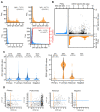Serological Evidence of Widespread Zika Transmission across the Philippines
- PMID: 34452307
- PMCID: PMC8402696
- DOI: 10.3390/v13081441
Serological Evidence of Widespread Zika Transmission across the Philippines
Abstract
Zika virus (ZIKV) exposure across flavivirus-endemic countries, including the Philippines, remains largely unknown despite sporadic case reporting and environmental suitability for transmission. Using laboratory surveillance data from 2016, 997 serum samples were randomly selected from suspected dengue (DENV) case reports across the Philippines and assayed for serological markers of short-term (IgM) and long-term (IgG) ZIKV exposure. Using mixture models, we re-evaluated ZIKV IgM/G seroprevalence thresholds and used catalytic models to quantify the force of infection (attack rate, AR) from age-accumulated ZIKV exposure. While we observed extensive ZIKV/DENV IgG cross-reactivity, not all individuals with active DENV presented with elevated ZIKV IgG, and a proportion of dengue-negative cases (DENV IgG-) were ZIKV IgG-positive (14.3%, 9/63). We identified evidence of long-term, yet not short-term, ZIKV exposure across Philippine regions (ZIKV IgG+: 31.5%, 314/997) which was geographically uncorrelated with DENV exposure. In contrast to the DENV AR (12.7% (95%CI: 9.1-17.4%)), the ZIKV AR was lower (5.7% (95%CI: 3-11%)) across the country. Our results provide evidence of widespread ZIKV exposure across the Philippines and suggest the need for studies to identify ZIKV infection risk factors over time to better prepare for potential future outbreaks.
Keywords: Philippines; Zika; dengue; diagnostics; force of infection; serology.
Conflict of interest statement
The authors declare no conflict of interest. The funders had no role in the design of the study; in the collection, analyses or interpretation of data; in the writing of the manuscript; or in the decision to publish the results.
Figures




References
-
- World Health Organization Zika Epidemiological Update Report. [(accessed on 14 July 2021)]; Available online: https://www.who.int/emergencies/diseases/zika/zika-epidemiology-update-j....
-
- Cao-Lormeau V.-M., Blake A., Mons S., Lastère S., Roche C., Vanhomwegen J., Dub T., Baudouin L., Teissier A., Larre P., et al. Guillain-Barré Syndrome outbreak associated with Zika virus infection in French Polynesia: A case-control study. Lancet. 2016;387:1531–1539. doi: 10.1016/S0140-6736(16)00562-6. - DOI - PMC - PubMed
-
- Brady O.J., Osgood-Zimmerman A., Kassebaum N.J., Ray S.E., de Araújo V.E.M., Da Nóbrega A.A., Frutuoso L.C.V., Lecca R.C.R., Stevens A., Zoca de Oliveira B., et al. The association between Zika virus infection and microcephaly in Brazil 2015-2017: An observational analysis of over 4 million births. PLoS Med. 2019;16:e1002755. doi: 10.1371/journal.pmed.1002755. - DOI - PMC - PubMed
Publication types
MeSH terms
Substances
Grants and funding
LinkOut - more resources
Full Text Sources
Medical
Research Materials

